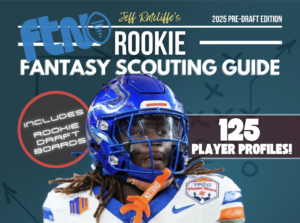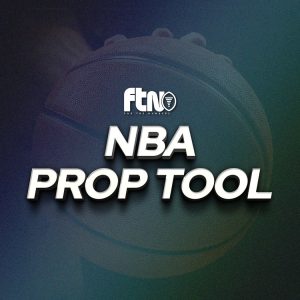
Whether you like it or not, every player in fantasy football comes with some level of risk. It could be injury risk, supporting cast concerns, age or a number of other factors. Even the best players aren’t immune to risk, and your personal risk tolerance should impact who you’re willing to target at the top of drafts.
In this piece, I’m playing devil’s advocate and identifying the biggest risk factor for the top-10 running backs in our FTN Fantasy rankings. I’ll evaluate how concerned you should be by each of these factors, and then it’ll be up to you to determine whether you’re willing to stomach the risk.
One note: Every football player carries injury risk. Unless that risk is an outsized one — a known injury or a track record — assume that everything here is “assumed healthy.”
RB1: Jonathan Taylor, Indianapolis Colts
The main reason Jonathan Taylor is the consensus RB1 is because he carries substantially less risk than many of the other backs you’re considering at the top of drafts. His age, lack of injury history, coaching staff and offensive line are all reasons we shouldn’t be concerned. If we squint hard enough though, we can identify a few reasons to consider avoiding Taylor with the #1 overall pick.
Last season, Taylor accumulated 331.1 fantasy points (standard scoring), or 19.6 on a per-game basis. It’s rare to see a player finish as the overall RB1 but fall short of the 20.0 PPG mark. While Taylor may be a safer pick at the top of drafts, he doesn’t possess the other-worldly upside that other options at the 1.01 do.
Risk Level: Low
Even if Taylor’s ceiling may not be as high as fantasy football’s all-time greats, he’s anything but a risky prospect. You may be passing on players with higher ceilings to draft him, but it’s his floor that makes him the 1.01 in redraft formats.
RB2: Christian McCaffrey, Carolina Panthers
We all know the risk with Christian McCaffrey. He’s played just 10 games combined over the past two seasons, and his massive workload during his first few years in the league has many wondering if he’s got anything left in the tank.
Every running back comes with injury risk, but McCaffrey’s is noticeably higher than most. It hasn’t just been one nagging injury either. Over the past two years, he’s suffered injuries to his shoulder, ankle, hamstring and glute. Considering Carolina may not be very competitive this year, there will be less incentive for both the team and McCaffrey to rush him back on the field if he suffers even a minor injury.
Risk Level: High
We’ve seen McCaffrey handle huge workloads in the past, so it wouldn’t be unprecedented for him to handle a large volume of touches this upcoming season. If he can remain healthy in 2022, he’s a locked-in top-three option at the position, but he’s the definition of a home-run swing.
RB3: Austin Ekeler, Los Angeles Chargers
Ever since Melvin Gordon’s departure, the Chargers have struggled to find a back to complement Austin Ekeler’s skill set. This year, Los Angeles spent a fourth-round selection on Isaiah Spiller – running back from Texas A&M – and his presence could eat into some of Ekeler’s previously massive workload.
More often than not, fourth-round picks don’t cause incumbent starters to worry about their job security. Spiller shouldn’t be usurping Ekeler on the depth chart anytime soon, but he has a complementary skill set that could help him demand some of the touches that have gone Ekeler’s way these past few seasons.
Risk Level: Low
Because Ekeler’s an undersized back, it would make sense for the Chargers to try to lighten his workload a bit. It’s hard to envision Spiller taking meaningful snaps from Ekeler this season, but if he earns just a handful of touches each week, those touches would likely come at Ekeler’s expense.
RB4: Dalvin Cook, Minnesota Vikings
While Dalvin Cook’s age and injury history are red flags that managers can’t deny, a much less heralded risk is the turnover on the Vikings coaching staff. Most are excited about the fact that Minnesota has an offensive-minded head coach in Kevin O’Connell, but even if his presence boosts the offense’s overall output, it could have a negative impact on Cook’s fantasy value.
O’Connell has never called plays before, and it’s tough to predict how he’ll ultimately deploy the Vikings backfield. There’s no question that Cook is the most talented back on the roster, but for the sake of fresh legs, injury prevention, or simply variety, O’Connell may prefer more of a committee approach in the backfield, which is every fantasy manager’s worst nightmare.
Risk Level: Moderate
However O’Connell decides to deploy his backfield will have a serious impact on Cook’s fantasy season. If he makes Cook the bellcow he was during the Mike Zimmer era, that’s great for fantasy production but increases Cook’s injury risk. On the flip side, if he tries to conserve Cook by utilizing Alexander Mattison more often, Cook’s overall upside could take a massive dip.
RB5: Derrick Henry, Tennessee Titans
Derrick Henry is down at #5 on this list because a broken foot caused him to miss half of the 2021 season. However, I don’t believe injury risk is his biggest concern entering 2022.
When Tennessee traded away A.J. Brown this offseason, they lost the only other guy on their offense who struck fear in the eyes of opposing defenders. They followed the Vikings playbook by replacing Brown with first-round rookie Treylon Burks, but Burks is a volatile prospect who remains an unknown at the NFL level.
During his last few seasons in Tennessee, Henry had been the primary focus of NFL defenses. With Brown out of the picture, opposing defenders will have less to worry about outside of Henry, which could lead to more of an uphill battle for the Tennessee rushing attack.
Risk Level: Moderate
It’s likely that without Brown in the equation, the entire Tennessee offense takes a step back in 2022. This would likely have a negative impact on Henry’s fantasy football season, but he should still see the touches necessary to remain a stable option for fantasy managers.
RB6: D’Andre Swift, Detroit Lions
There weren’t many members of the Lions offense that attracted fantasy managers last year, but D’Andre Swift was certainly one of them. The electric second-year back was equally as impressive on the ground as he was through the air, and he eclipsed the 1,000 yard from scrimmage mark despite playing just 13 games.
This offseason, the Lions brought in Jameson Williams and DJ Chark to provide some extra juice to their passing attack, which means Swift should have some stiffer competition for touches this season. Throw in the fact that Detroit likes to rotate their backfield between Swift and Jamaal Williams, and there’s a world where Swift doesn’t see enough volume to crack fantasy football’s top-five backs.
Risk Level: Low
Even with the added talent on offense, Swift should have no problem demanding touches due to his supreme talent. He’ll continue to have an ever-valuable role in the passing game, and the improved weapons around him could actually help Swift’s stock if they elevate the entire offense.
RB7: Najee Harris, Pittsburgh Steelers
At his current price tag, Najee Harris is one of my favorite picks in all of fantasy football this year. The second-year back proved capable of handling a massive workload last season, and Mike Tomlin and the Steelers have a history of utilizing a bellcow in their backfield.
The issue with Harris is the uncertainty surrounding the quarterback position. Harris caught a whopping 74 passes last year, many of which were a result of Ben Roethlisberger being unable to push the ball deep down the field. If the Steelers and their litany of pass-catching weapons are able to push the ball down the field a bit more with either Mitch Trubisky or Kenny Pickett under center, it could have a negative impact on the number of checkdowns Harris sees in 2022.
Risk Level: Low
Even though Trubisky and/or Pickett aren’t sexy options for the upcoming season, it’s hard to argue they’re a downgrade compared to Big Ben in his age-39 season. Even if Harris receives fewer checkdown targets, there’s no denying he’ll be a focal point of the Pittsburgh offense.
RB8: Joe Mixon, Cincinnati Bengals
Entering 2021, Joe Mixon was one of those draft picks that made fantasy managers feel a little queasy. He’s been no stranger to injuries throughout his career, and prior to last season, the Bengals offense wasn’t considered appealing for fantasy purposes.
However, Mixon stayed healthy last season, the Bengals offense exploded onto the scene and Mixon rewarded fantasy managers with an overall RB3 finish. The problem is, because Mixon played every game and the Bengals made it all the way to the Super Bowl, he accumulated a whopping 419 touches last season. Studies have shown that 370 is the magic number of touches that preclude a running back’s dropoff. Even if those studies are a little outdated, we can’t overlook the fact that there’s a clear correlation between RB workload and their future production.
Risk Level: High
If Mixon can produce another fully healthy season in a booming Bengals offense, he’ll once again be an elite fantasy option. The workload in 2021 paired with prior injury history should have fantasy managers drafting with caution, though.
RB9: Leonard Fournette, Tampa Bay Buccaneers
One of the biggest appeals when drafting Leonard Fournette is the opportunity for touchdowns in a high-powered Tampa Bay offense. The problem is, even if the Bucs are one of the league’s best offenses again in 2022, Fournette’s opportunity for touchdowns may not be as enticing as you initially assume.
Last season, no quarterback threw the ball when the offense was approaching the end zone more than Tom Brady. He threw a league-leading 60 passes and 24 touchdowns when the offense was inside the 10-yard line, and it’s unlikely his style of play changes much this season.
Risk Level: Low
Even if the slice of pie Fournette gets near the goal line isn’t as big as fantasy managers would like, it’s still a pretty big pie. He may not be atop the touchdown leaderboard come season’s end, but double-digit scores for Fournette feels very attainable in what should be a high-powered offense.
RB10: Alvin Kamara, New Orleans Saints
For the first time since 2006, the Saints will enter the season without Sean Payton as their head coach. Payton was one of the brightest offensive minds the league had ever seen, and one of his trademark traits was his creative use of running backs in the passing game.
Alvin Kamara’s versatile skill set was a dream fit for Payton’s offense, and it’ll be interesting to see how much of an impact Payton’s departure has on Kamara’s fantasy production. To add fuel to the fire, in his first year without Drew Brees under center, Kamara saw a career-low 5.2 targets per game. There are legitimate concerns that the receiving work that made Kamara a fantasy football stud for the last half-decade could see a sizable dropoff this upcoming season.
Risk Level: Moderate
Even if the receiving work takes a dip, from a talent perspective, Kamara should still be one of the 10 best backs in the league this year. He may not possess the immense ceiling we saw just a few short years ago, but as long as the Saints don’t take a complete nosedive on offense this year, Kamara’s floor should remain relatively high.












































 New York Jets
New York Jets  New England Patriots
New England Patriots  Miami Dolphins
Miami Dolphins  Buffalo Bills
Buffalo Bills  Pittsburgh Steelers
Pittsburgh Steelers  Cleveland Browns
Cleveland Browns  Cincinnati Bengals
Cincinnati Bengals  Baltimore Ravens
Baltimore Ravens  Tennessee Titans
Tennessee Titans  Jacksonville Jaguars
Jacksonville Jaguars  Indianapolis Colts
Indianapolis Colts  Houston Texans
Houston Texans  Las Vegas Raiders
Las Vegas Raiders  Los Angeles Chargers
Los Angeles Chargers  Kansas City Chiefs
Kansas City Chiefs  Denver Broncos
Denver Broncos  Washington Commanders
Washington Commanders  Philadelphia Eagles
Philadelphia Eagles  New York Giants
New York Giants  Dallas Cowboys
Dallas Cowboys  Minnesota Vikings
Minnesota Vikings  Green Bay Packers
Green Bay Packers  Detroit Lions
Detroit Lions  Chicago Bears
Chicago Bears  Tampa Bay Buccaneers
Tampa Bay Buccaneers  New Orleans Saints
New Orleans Saints  Carolina Panthers
Carolina Panthers  Atlanta Falcons
Atlanta Falcons  San Francisco 49ers
San Francisco 49ers  Seattle Seahawks
Seattle Seahawks  Los Angeles Rams
Los Angeles Rams  Arizona Cardinals
Arizona Cardinals 








 Boston Celtics
Boston Celtics  Brooklyn Nets
Brooklyn Nets  Philadelphia 76ers
Philadelphia 76ers  New York Knicks
New York Knicks  Toronto Raptors
Toronto Raptors  Chicago Bulls
Chicago Bulls  Detroit Pistons
Detroit Pistons  Milwaukee Bucks
Milwaukee Bucks  Cleveland Cavaliers
Cleveland Cavaliers  Indiana Pacers
Indiana Pacers  Orlando Magic
Orlando Magic  Atlanta Hawks
Atlanta Hawks  Charlotte Hornets
Charlotte Hornets  Miami Heat
Miami Heat  Washington Wizards
Washington Wizards  Denver Nuggets
Denver Nuggets  Minnesota Timberwolves
Minnesota Timberwolves  Oklahoma City Thunder
Oklahoma City Thunder  Portland Trail Blazers
Portland Trail Blazers  Utah Jazz
Utah Jazz  LA Clippers
LA Clippers  Golden State Warriors
Golden State Warriors  Los Angeles Lakers
Los Angeles Lakers  Phoenix Suns
Phoenix Suns  Sacramento Kings
Sacramento Kings  Dallas Mavericks
Dallas Mavericks  Houston Rockets
Houston Rockets  Memphis Grizzlies
Memphis Grizzlies  New Orleans Pelicans
New Orleans Pelicans  San Antonio Spurs
San Antonio Spurs 











